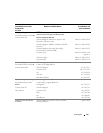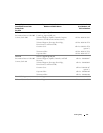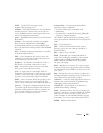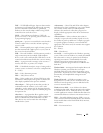
156 Glossary
cm — Centimeter(s).
cmos — Complementary metal-oxide semiconductor.
component — As they relate to DMI, components
include operating systems, computer systems, expansion
cards, and peripherals that are compatible with DMI.
Each component is made up of groups and attributes that
are defined as relevant to that component.
COMn — The device names for the serial ports on your
system.
control panel — The part of the system that contains
indicators and controls, such as the power button and
power indicator.
controller — A chip that controls the transfer of data
between the processor and memory or between the
processor and a peripheral.
conventional memory — The first 640 KB of RAM.
Conventional memory is found in all systems. Unless they
are specially designed, MS-DOS
®
programs are limited to
running in conventional memory.
coprocessor — A chip that relieves the system’s processor
of specific processing tasks. A math coprocessor, for
example, handles numeric processing.
CPU — Central processing unit. See processor.
DC — Direct current.
DDR — Double-data rate. A technology in memory
modules that potentially doubles the output.
device driver — A program that allows the operating
system or some other program to interface correctly with a
peripheral. Some device drivers—such as network
drivers—must be loaded from the config.sys file or as
memory-resident programs (usually, from the
autoexec.bat file). Others must load when you start the
program for which they were designed.
DHCP — Dynamic Host Configuration Protocol. A
method of automatically assigning an IP address to a
client system.
diagnostics — A comprehensive set of tests for your
system.
DIMM — Dual in-line memory module. See also memory
module.
DIN — Deutsche Industrie Norm.
directory — Directories help keep related files organized
on a disk in a hierarchical, “inverted tree” structure. Each
disk has a “root” directory. Additional directories that
branch off the root directory are called subdirectories.
Subdirectories may contain additional directories
branching off them.
DMA — Direct memory access. A DMA channel allows
certain types of data transfer between RAM and a device
to bypass the processor.
DMI — Desktop Management Interface. DMI enables
the management of your system’s software and hardware
by collecting information about the system’s components,
such as the operating system, memory, peripherals,
expansion cards, and asset tag.
DNS — Domain Name System. A method of translating
Internet domain names, such as www.dell.com, into IP
addresses, such as 143.166.83.200.
DRAM — Dynamic random-access memory. A system’s
RAM is usually made up entirely of DRAM chips.
DVD — Digital versatile disc.
ECC — Error checking and correction.
EEPROM — Electronically erasable programmable read-
only memory.
EMC — Electromagnetic compatibility.
EMI — Electromagnetic interference.
ERA — Embedded remote access. ERA allows you to
perform remote, or "out-of-band," server management on
your network server using a remote access controller.
ESD — Electrostatic discharge.
ESM — Embedded server management.
expansion bus — Your system contains an expansion bus
that allows the processor to communicate with controllers
for peripherals, such as NICs.
expansion card — An add-in card, such as a NIC or SCSI
adapter, that plugs into an expansion-card connector on
the system board. An expansion card adds some
specialized function to the system by providing an
interface between the expansion bus and a peripheral.


















